
Due to the sampling interval of the isco's taking in meltwater from Linnebreen, a group must venture up to the glacier on a regular 3 day rotation. That's (24) 0.5 liter water samples taken every 3 hours for each of the iscos totaling 24 liters that must be returned to the Isfjord Radio for filtering, processing, and general advancement of joint pain and early-onset arthritis. Today it was Lauren, Lukas, and I joining Kayla and John for a trip to the glacier…
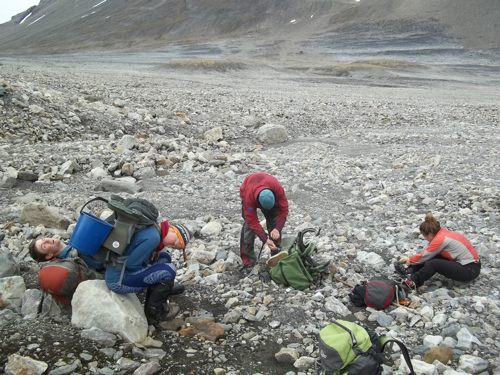
Our group totals 15 in all. That includes 2 professors, 1 PolarTREC teacher, 1 masters student (Sara), 6 UNIS AG212 students, and 5 REU students. Between these distinguished individuals there are 3 sets of Karst lake projects being completed in pairs, 1 karst lake/periglacial masters thesis, and 5 different REU thesis projects that are all loosely related within the glacier/stream/lake environment. On any given day, team members may be working solo or in pairs on their own research or being bribed with promises of chocolate to work as field assistants on another's. This dynamic keeps you constantly seeing new environments and science while always pushing forward your own work. My particular project continues onward with each keyboard callous and the luxury of being able to hop from project to project, albeit the perma-field assistant lugging and digging take their toll.
TGIF and the weather was beautiful. John and Kayla had not had quite the splendid weather on yesterday's trip so hopefully their likely tired legs were rejuvenated by today's sunshine for the return trip. The hike in was a bit more direct this trip due to the fact that everyone had muck boots so were able to bee-line it through the braided meltwater channels direct to the Little Ice Age moraine below Linnebreen. Following lunch on the moraine and our noon radio check-in we ventured up to the first of the isco sites (I get a little smile each time I type 'isco' as the computer auto-correct is bound and determined that we visit a 'disco' site instead).
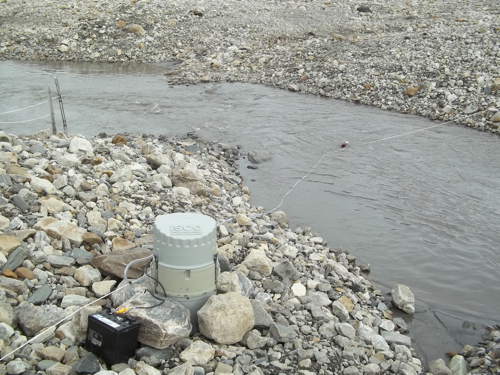
We arrived with time to spare given the fact that the last of the 24 samples was set to fill at 3 pm so we headed up to the glacier for some meltwater observations for John's thesis work. Without the rush of trying to take in all of the surficial geologic remnants of past glacier margins or ablation stake measurements we were able to take in a lot more of what was happening on and around the actual glacier ice. Some notes of field notes of interest for the afternoon:
-The glacier surface below the snow line was covered in sediment and superimposed ice. Small, quarter sized portholes looking into clear ice could be found to take up roughly 10% of any given area on the ice surface.
-Small supra-glacial meltwater streams were common exploiting fractures/joints in the ice surface. The most common orientation of joints was parallel to the glacier margin, running perpendicular to ice flow, and streams would follow these joints for a bit but then run out whenever they met other joints that were much more oriented to flow draining the fall line.
-Meltwater streams ran on top of the ice until about half way the distance between the upper elevation snow line and the glacier terminus. There, the streams would often join together until they had enough volume and force to plunge through the ice surface and run sub-glacially, often creating impressive waterfalls and caverns.
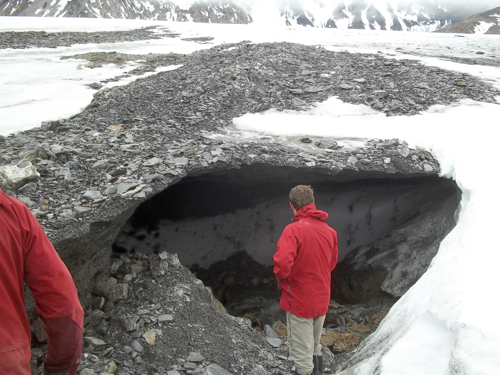
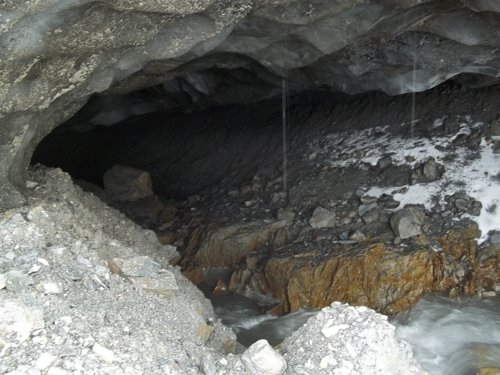
-Remnants of past glacial drainages were present in the form of sedimentary deposits formed in either protected former caverns (such as in the glacier-up side of the earlier caverns) or supra-glacial meltwater fans. I've yet to decide or consult the experts…thoughts?
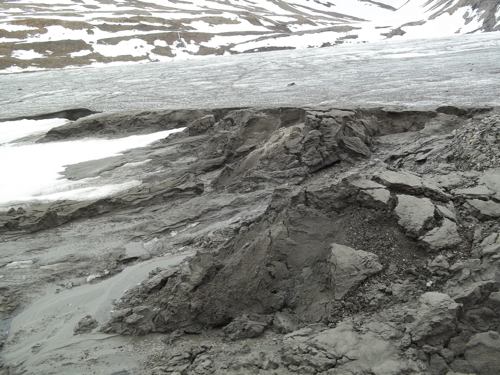
Notes done for now…
GlacierA mass of ice that persists for many years and notably deforms and flows under the influence of gravity. observations were complete at about 2:45 pm so we worked our way down to the upper isco site and observed the 'whirr' of peristaltic pumps bringing in the last meltwater sample. We swapped out the full bottles with empty replacements, loaded our packs, and repeated the process at the lower site.
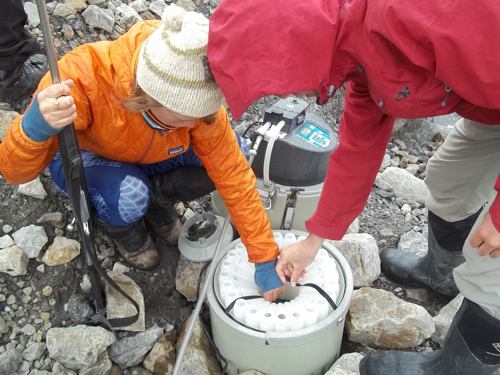
With our packs loaded down with (48) 0.5 liter sample bottles, which if my math is right totals 24 kg, it was time to start the trek back to the south boat park and hopefully make our 7 pm dinner. What a silly science it is that we find the need to shuttle rocks and water such great distances…
We made it to the south boat park just behind a cohort of ours working on the weather station and all rendezvoused at the north end of the lake for the hike back to Isfjord Radio. Steve was the lucky one that got to hike the borrowed ladder back to the station (which he did mention beat having someone stand on his shoulders to fix weather station instruments and drop tools onto his head, true story from years past).
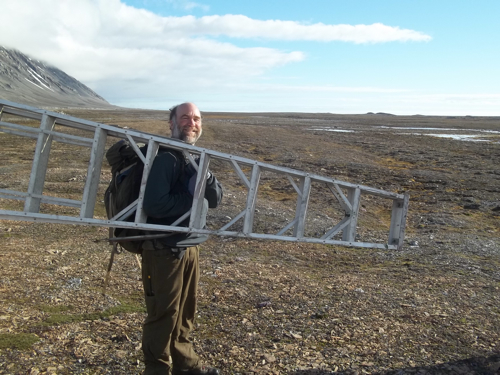
To cap off a tiring day were met by our favorite flying friends whose welcome back to camp we've become accustomed to…as Steve says "Angry Birds Arctic Edition, the terns." Swooping and shrieking at us, they said 'hello' and wished us a happy Friday…
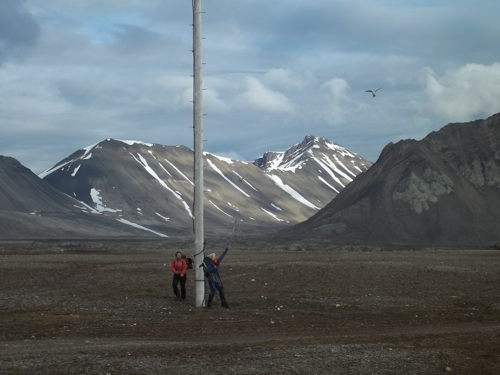
To follow up the first image, here are two more recent views of Linnebreen working its way through the melt season.
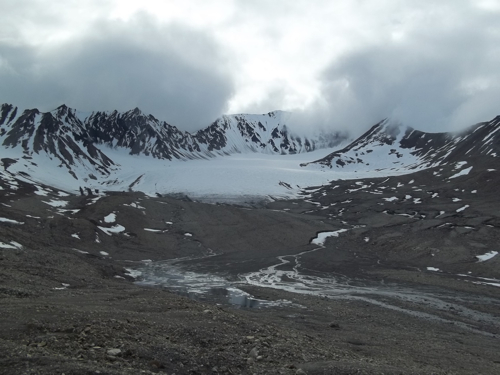
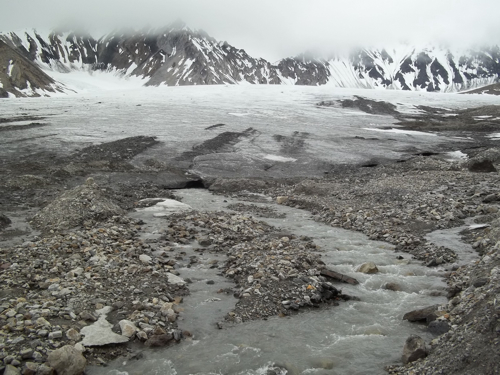


Comments